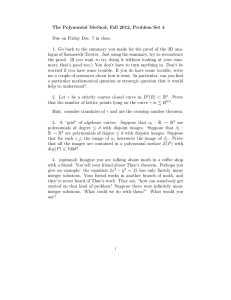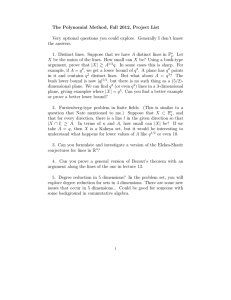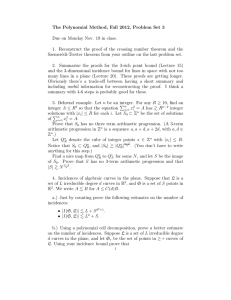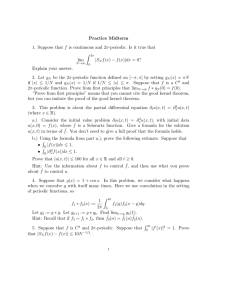APPLICATION TO INCIDENCE THEORY OF LINES IN SPACE
advertisement
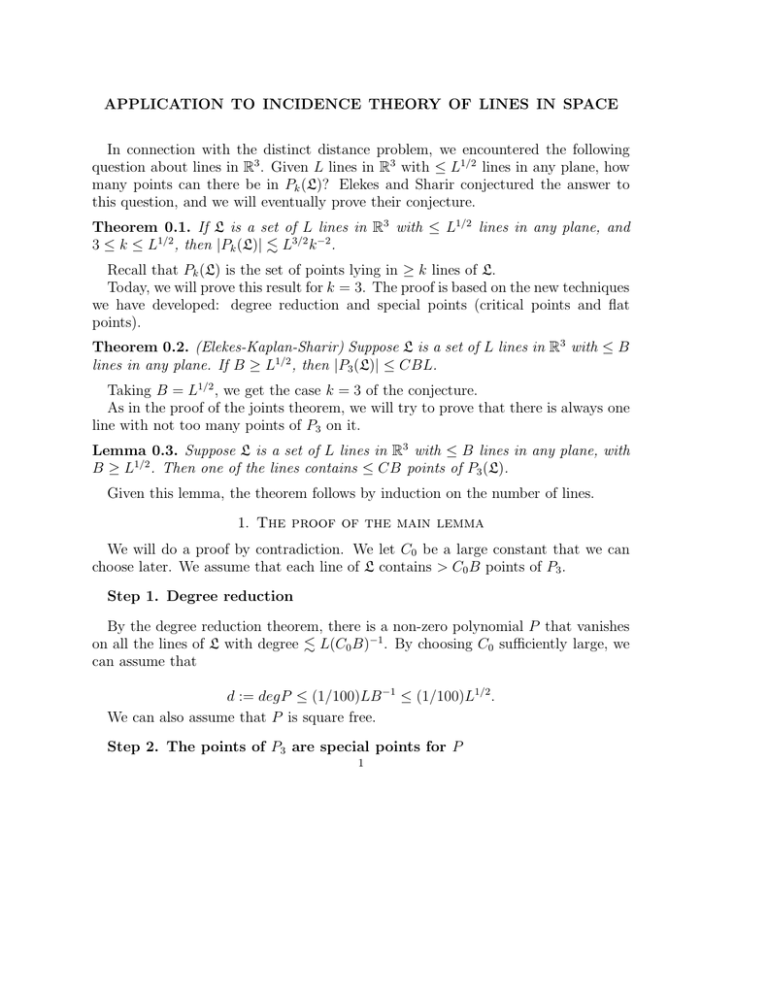
APPLICATION TO INCIDENCE THEORY OF LINES IN SPACE
In connection with the distinct distance problem, we encountered the following
question about lines in R3 . Given L lines in R3 with ≤ L1/2 lines in any plane, how
many points can there be in Pk (L)? Elekes and Sharir conjectured the answer to
this question, and we will eventually prove their conjecture.
Theorem 0.1. If L is a set of L lines in R3 with ≤ L1/2 lines in any plane, and
3 ≤ k ≤ L1/2 , then |Pk (L)| . L3/2 k −2 .
Recall that Pk (L) is the set of points lying in ≥ k lines of L.
Today, we will prove this result for k = 3. The proof is based on the new techniques
we have developed: degree reduction and special points (critical points and flat
points).
Theorem 0.2. (Elekes-Kaplan-Sharir) Suppose L is a set of L lines in R3 with ≤ B
lines in any plane. If B ≥ L1/2 , then |P3 (L)| ≤ CBL.
Taking B = L1/2 , we get the case k = 3 of the conjecture.
As in the proof of the joints theorem, we will try to prove that there is always one
line with not too many points of P3 on it.
Lemma 0.3. Suppose L is a set of L lines in R3 with ≤ B lines in any plane, with
B ≥ L1/2 . Then one of the lines contains ≤ CB points of P3 (L).
Given this lemma, the theorem follows by induction on the number of lines.
1. The proof of the main lemma
We will do a proof by contradiction. We let C0 be a large constant that we can
choose later. We assume that each line of L contains > C0 B points of P3 .
Step 1. Degree reduction
By the degree reduction theorem, there is a non-zero polynomial P that vanishes
on all the lines of L with degree . L(C0 B)−1 . By choosing C0 sufficiently large, we
can assume that
d := degP ≤ (1/100)LB −1 ≤ (1/100)L1/2 .
We can also assume that P is square free.
Step 2. The points of P3 are special points for P
1
2
APPLICATION TO INCIDENCE THEORY OF LINES IN SPACE
Recall that a point x ∈ Z(P ) is called special if it is either critical or flat. Special
points can be detected by polynomials. Last lecture, we defined a vector of polynomials SP (x) so that x is special if and only if P (x) = 0 and SP (x) = 0. Each
component of SP (x) has degree ≤ 3d − 4, and there are nine components.
We claim that each point of P3 is either critical or flat. Let x ∈ P3 . By definition,
x lies in (at least) three lines of L. Pick three lines l1 , l2 , l3 containing x. We know
that P = 0 on these three lines. If the three lines are not coplanar, then we saw in
our study of joints that x is a critical point of P . The reason is that ∂vi P (x) = 0
where vi are the tangent directions to the three lines. Since these directions form a
basis of R3 , ∇P (x) = 0. Suppose now that x is not a critical point of P . In this
case, we will prove that x is a flat point of Z(P ).
We see that the lines l1 , l2 , l3 must lie in a plane. We still have ∂vi P (x) = 0 for each
i, and so the lines li must all lie in the tangent plane to Z(P ) at x. Next we perform
a translation and rotation so that x is moved to 0 and Z(P ) is locally described as
a graph
x3 = f (x1 , x2 ) = Q(x1 , x2 ) + O(|x1 | + |x2 |)3 , Q homogeneous of degree 2.
The translation and rotation moves the lines li to lines ˜li which contain 0 and lie in
the plane x3 = 0. Since these lines lie in the image of Z(P ), we see that f vanishes
on them. Therefore, Q must vanish on them. So we see that the quadratic form
Q vanishes on three lines through 0 in R2 . Now by the vanishing lemma, Q must
also vanish on any line that passes through the three lines at distinct points, and it
quickly follows that Q = 0. This means that the point x is flat.
Each point of P3 is either critical or flat, and so SP (x) = 0 for each x ∈ P3 .
Step 3. The lines of L are special lines for P
Each line of L contains ≥ C0 B ≥ L1/2 points of P3 . On the other hand, the
polynomial P has degree ≤ (1/100)L1/2 . The polynomials in SP have degree ≤
3d − 4 ≤ (3/100)L1/2 . Each polynomial SP vanishes at ≥ L1/2 points on each line
of L. Therefore, SP = 0 on each line of L.
Step 4. Almost all the lines of L must lie in planes of Z(P )
Q
Suppose that P = j Pj with Pj irreducible. Some of the Pj may be linear, and
each linear factor corresponds to a plane in Z(P ). Let π1 , ..., πT be all the planes in
Z(P ), with T ≤ d ≤ (1/100)L1/2 . Next we consider how special lines of Z(P ) relate
to special lines of the Z(Pj ).
APPLICATION TO INCIDENCE THEORY OF LINES IN SPACE
3
Lemma 1.1. Suppose that l ⊂ Z(P ) is a special line, i.e. SP = 0 on l. Then either
l lies in Z(Pj ) for two different j, or else l is a special line of Z(Pj ) for some j.
(We note that if l lies in Z(Pj ) for two different j, then ∇P = 0 on l, so l is a
special line.)
Proof. Let l be a special line of Z(P ). Suppose that l lies in Z(Pj1 ) but l does not
lie in any other Z(Pj ). We have to show that l is a special line of Z(Pj1 ). First,
suppose that l is a critical line of Z(P ) - in other words, ∇P = 0 on l. We expand
∇P using the Liebniz formula:
∇P =
X
j0
(∇Pj0 )
Y
Pj .
j6=j0
Q
Along the line l, Pj1 = 0, and so the sum simplifies to (∇Pj1 ) j6=j1 Pj . At all but
finitely many points of l, the product does not vanish, and so ∇Pj1 must vanish. By
the vanishing lemma, ∇Pj1 = 0 on l.
Next, suppose that l is not a critical line and is a flat line. For almost every point
x ∈ L, Z(P ) is a smooth manifold near x and Z(P ) is flat at x. But for almost every
point x in l, Z(P ) = Z(Pj1 ) in a small neighborhood of x. So Z(Pj1 ) is flat at almost
every point x ∈ l. Therefore, SPj1 (x) = 0 for almost every x ∈ l. By the vanishing
lemma, SPj1 = 0 on l.
Now we count the number of special lines of various types,
Pusing the Bezout theorem. The number of lines that lie in at least two Z(Pj ) is ≤ j1 ,j2 (degPj1 )(degPj2 ) ≤
d2 ≤ 10−4 L.
If Pj is not a linear polynomial, then we proved last time that the number of
special lines in Z(Pj ) is ≤ 3(degPj )2 .PTherefore, the number of special lines in Z(Pj )
for all the Pj with degPj ≥ 2 is ≤ 3 j (degPj )2 ≤ 3d2 ≤ 3 · 10−4 L.
Therefore, at least (99/100)L lines of L must lie in the planes π1 , ..., πT , with
T ≤ d ≤ (1/100)L/B. By the pigeon hole principle, one of the planes contains at
least 99B lines of L. But we assumed that each plane contains ≤ B lines of L. This
contradiction proves the lemma.
2. What happens for large k?
We will eventually prove the following theorem.
If L is a set of L lines in R3 with ≤ L1/2 lines in any plane and if 3 ≤ k ≤ L1/2 ,
then |Pk (L)| . L3/2 k −2 .
Suppose that L is a set of L lines in R3 with ≤ L1/2 lines in any plane. We would
like to show that one of the lines contains ≤ L1/2 k −1 points of Pk (L). (For heuristic
purposes, suppose that each line had L1/2 k −1 points of Pk . Then we would have
4
APPLICATION TO INCIDENCE THEORY OF LINES IN SPACE
L3/2 k −1 incidences between L and Pk . But each point of Pk lies on ≥ k lines, so we
would have ≤ L3/2 k −2 points of Pk .)
Let us suppose that each line contains ≥ A points of Pk . For which values of A
can we hope to run the argument above? In order for the argument to work, it’s
crucial to be able to do degree reduction. Let us do a heuristic calculation of how
big A needs to be to do degree reduction.
Let d be a degree that we can pick later. We find a non-zero polynomial P of
degree ≤ d that vanishes on (1/10)d2 random lines of L. Let l be another line of
L. We want to estimate the number of points where this line intersects the random
lines above. The line l contains A points of Pk . Each of these points lies in ≥ k
lines of L, and so l intersects ≥ Ak lines of L. Each line of L has a probability
∼ d2 /L of being chosen in the list of random lines. Therefore, the number of lines of
L which intersect l is typically Akd2 /L. If this number is < A, then the number of
distinct intersection points is typically of the same order of magnitude. The number
of intersection points is capped at A, so we have
E|{x ∈ l|x ∈ the d2 random lines }| & min(Akd2 L−1 , A).
We can do degree reduction only if this expected number is > d. So to do degree
reduction we need Akd2 L−1 > d and A > d. The first inequality is equivalent to
d > LA−1 k −1 . So to do degree reduction, we need A > d > LA−1 k −1 and hence
A > L1/2 k −1/2 . If A is, say, ≥ 105 L1/2 k −1/2 , then we can do degree reduction down to
degree d ∼ LA−1 k −1 . The rest of the argument above works. Filling in the details,
it is possible to prove the following fairly weak estimate:
Proposition 2.1. Suppose that L is a set of L lines in R3 with ≤ L1/2 lines in any
plane. Suppose 3 ≤ k ≤ L1/2 . Then one of the lines contains . L1/2 k −1/2 points of
Pk .
Then, by a somewhat tricky induction argument we get
Corollary 2.2. Suppose that L is a set of L lines in R3 with ≤ L1/2 lines in any
plane. Suppose 3 ≤ k ≤ L1/2 . Then |Pk | . L3/2 k −3/2 .
This estimate is significantly weaker than the theorem we will eventually prove.
What is the source of our difficulties, and why are we getting stuck at this point?
It’s interesting to consider the example of lines in finite fields. Let L be the set
of all the lines in F3q . The total number of lines is L ∼ q 4 . The number of lines
in any plane is ∼ q 2 ≤ L1/2 . Each point of Fq lies in k ∼ q 2 lines. Therefore
|Pk (L)| = q 3 ∼ L3/2 k −3/2 .
This situation is similar to the Szemerédi-Trotter theorem. The Szemerédi-Trotter
theorem is true for lines in R2 . But it’s false over finite fields, in particular if we
APPLICATION TO INCIDENCE THEORY OF LINES IN SPACE
5
consider the set of all lines in F2q . The known proofs all somehow use the topology
of R2 . Theorem 0.1 has very similar difficulties.
On the other hand, the case k = 3 of Theorem 0.1 has a nice proof with the
polynomial method. This case seems at least as hard as the joints problem, and no
one knows how to approach it (so far) without the polynomial method.
So the problem combines the difficulties of the Szemerédi-Trotter theorem and
the joints theorem. To prove it, we will need to combine some type of topological
argument as in the ST theorem with some type of polynomial argument as in the
joints theorem. Our next main goal in the course is to see how to get these two
methods to cooperate.
2.1. On the tricky induction. Here we describe, for reference, the slightly tricky
inductive argument to get the corollary from the proposition. Actually, to do the
induction we need a slightly more general proposition.
Proposition 2.3. Suppose that 3 ≤ k ≤ 10L1/2 . Suppose that L is a set of L lines in
R3 with ≤ B lines in any plane, with B ≥ L1/2 . Then one of the lines of L contains
. Bk −1/2 points of Pk .
Proof sketch. Suppose that each line contains ≥ A points of Pk . If A ≥ 105 L1/2 k −1/2 ,
then we can do degree reduction to fit all the lines in Z(P ) for P of degree ≤
CLA−1 k −1 . This degree is ≤ (1/100)A and ≤ (1/100)L1/2 . All the points of Pk
are special points of Z(P ). Since A > 3degP , all the lines are special lines. Since
degP ≤ (1/100)L1/2 , Z(P ) only has room for < (1/100)L special lines except in the
planes of Z(P ). So almost all the lines actually lie in ≤ d planes. One plane must
contain at least (1/2)L/d & Ak lines. Therefore,
A . min(L1/2 k −1/2 , Bk −1 ) ≤ Bk −1/2 .
Using this proposition and induction, we get the following corollary.
Corollary 2.4. Suppose that L is a set of L lines in R3 with ≤ B lines in any plane,
where B ≥ L1/2 . Suppose that 3 ≤ k ≤ L1/2 . Then |Pk | . LBk −3/2 .
Proof sketch. Remove the lines one at a time using the last lemma, until we get
down to (1/100)k 2 lines. At this point, we know that |Pk/2 | . k by the counting
bound. At each step, we remove a line that intersects . LBk −1/2 points of Pk/2 . By
the end, all but k point of Pk must have had k/2 lines removed. So we see
(|Pk (L)| − Ck)k . L(Bk −1/2 ).
Hence |Pk (L)| . LBk −3/2 .

